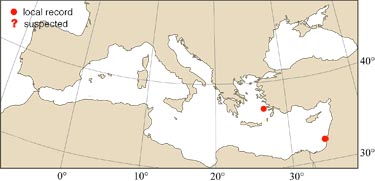
|
Relevant synonyms
Misidentification
Meristic formula
|
|
| photo : John E. Randall |
|
SHORT
DESCRIPTION
color :
back and flanks grey to brownish with two distinct longtitudal white lines on the sides. size : common 50-120 cm (max. 200 cm). |
DISTINGUISHING CHARACTERISTICS
BIOLOGY / ECOLOGY
habitat : pelagic, often over continental shelf. |
|
1st
MEDITERRANEAN RECORD
|

|
|
DISTRIBUTION
|
ESTABLISHMENT SUCCESS
speculated reasons for success :
|
|
|
MODE OF
INTRODUCTION |
IMPORTANCE TO
HUMANS |
|
KEY
REFERENCES
|